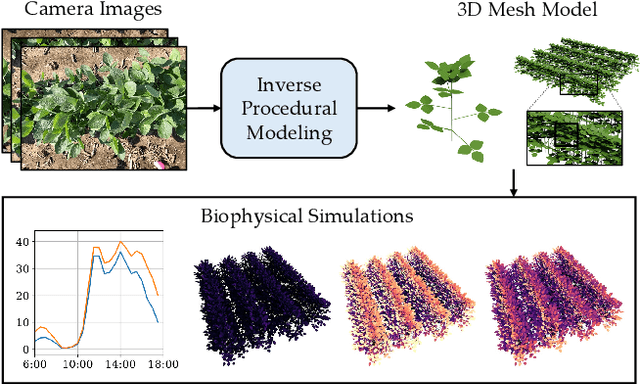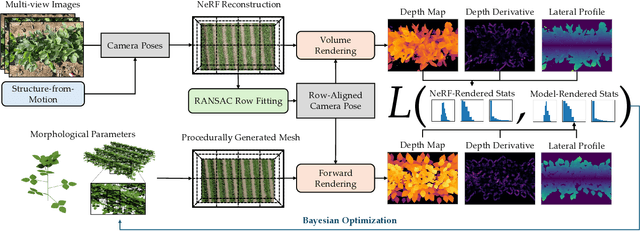Junxiong Zhou
CropCraft: Inverse Procedural Modeling for 3D Reconstruction of Crop Plants
Nov 14, 2024



Abstract:The ability to automatically build 3D digital twins of plants from images has countless applications in agriculture, environmental science, robotics, and other fields. However, current 3D reconstruction methods fail to recover complete shapes of plants due to heavy occlusion and complex geometries. In this work, we present a novel method for 3D reconstruction of agricultural crops based on optimizing a parametric model of plant morphology via inverse procedural modeling. Our method first estimates depth maps by fitting a neural radiance field and then employs Bayesian optimization to estimate plant morphological parameters that result in consistent depth renderings. The resulting 3D model is complete and biologically plausible. We validate our method on a dataset of real images of agricultural fields, and demonstrate that the reconstructions can be used for a variety of monitoring and simulation applications.
Mapping smallholder cashew plantations to inform sustainable tree crop expansion in Benin
Jan 01, 2023Abstract:Cashews are grown by over 3 million smallholders in more than 40 countries worldwide as a principal source of income. As the third largest cashew producer in Africa, Benin has nearly 200,000 smallholder cashew growers contributing 15% of the country's national export earnings. However, a lack of information on where and how cashew trees grow across the country hinders decision-making that could support increased cashew production and poverty alleviation. By leveraging 2.4-m Planet Basemaps and 0.5-m aerial imagery, newly developed deep learning algorithms, and large-scale ground truth datasets, we successfully produced the first national map of cashew in Benin and characterized the expansion of cashew plantations between 2015 and 2021. In particular, we developed a SpatioTemporal Classification with Attention (STCA) model to map the distribution of cashew plantations, which can fully capture texture information from discriminative time steps during a growing season. We further developed a Clustering Augmented Self-supervised Temporal Classification (CASTC) model to distinguish high-density versus low-density cashew plantations by automatic feature extraction and optimized clustering. Results show that the STCA model has an overall accuracy of 80% and the CASTC model achieved an overall accuracy of 77.9%. We found that the cashew area in Benin has doubled from 2015 to 2021 with 60% of new plantation development coming from cropland or fallow land, while encroachment of cashew plantations into protected areas has increased by 70%. Only half of cashew plantations were high-density in 2021, suggesting high potential for intensification. Our study illustrates the power of combining high-resolution remote sensing imagery and state-of-the-art deep learning algorithms to better understand tree crops in the heterogeneous smallholder landscape.
 Add to Chrome
Add to Chrome Add to Firefox
Add to Firefox Add to Edge
Add to Edge